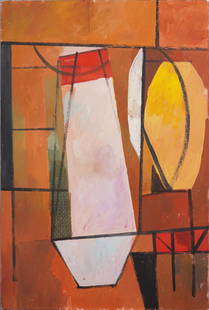
PHILIP GUSTON (1913-1980) ABSTRACT STILL LIFE PAINTING
Philip Guston Sale History
View Price Results for Philip Guston

Related Paintings
More Items from Philip Guston
View MoreRecommended Art
View More



Item Details
Description
Attributed Philip Guston - American New York 1913-1980 - Abstract representational still life oil painting on gold sheet metal panel depicting fruit near a bottle. Signed lower left bottom. H 11" x L 15". 17 1/2" x 21 1/2" Framed.
Guston was a painter and printmaker in the New York School, which included many of the abstract expressionists, such as Jackson Pollock and Willem de Kooning. In the late 1960s Guston helped to lead a transition from abstract expressionism to neo-expressionism in painting, abandoning the so-called "pure abstraction" of abstract expressionism in favor of more cartoonish renderings of various personal symbols and objects.
Born in 1913 in Montreal, Guston moved with his family to Los Angeles as a child, his Ukrainian Jewish parents having escaped persecution when they moved from Odessa, Ukraine, to Canada. Guston and his family were aware of the regular Klan activities against Jews, blacks and others which took place across California during Guston's childhood. When Guston was 10 or 11, his father hanged himself in the shed, and the young Guston found the body.
Guston began painting at the age of 14, and in 1927 he enrolled in the Los Angeles Manual Arts High School, where both he and Jackson Pollock studied under Frederick John de St. Vrain Schwankovsky and were introduced to modern European art, oriental philosophy, theosophy and mystic literature.Guston's early work was figurative and representational. His mother supported his artistic inclinations, and he often made drawings in a small closet, lit by a hanging bulb.
Apart from his high school education and a one-year scholarship at the Otis Art Institute in Los Angeles, Guston remained a largely self-taught artist. During high school, Guston and Jackson Pollock published a paper opposing the high school's emphasis on sports over art. Their criticism led to both being expelled, but Pollock returned and graduated. At Otis on scholarship, Guston felt unfulfilled by the academic approach which limited him to drawing from plaster casts instead of the live model. Before dropping out of Otis, Guston spent a night in the studio making drawings of these figurative plasters scattered all over the studio floor. A two-page review in Time magazine quoted Siqueiros describing them as "the most promising painters in either the US or Mexico". While in Mexico he also met and spent time with Frida Kahlo and her husband Diego Rivera.
In 1934-35, Guston and Kadish completed another mural at City of Hope, at the time a tuberculosis hospital located in Duarte, California, that remains to this day.
In September 1935 he moved to New York where he worked as an artist in the WPA program. In 1937 he married an artist and poet he first met at Otis, Musa McKim. They collaborated on several WPA murals. During this period his work included strong references to Renaissance painters such as Paolo Uccello, Masaccio, Piero della Francesca and Giotto. He was also influenced by American Regionalists and Mexican mural painters. In 1938 he painted a post office mural in the US post office in Commerce, Georgia, entitled Early Mail Service and the Construction of Railroads.A powerful and enduring influence, whom Guston was to acknowledge throughout his career, was Italian painter Giorgio de Chirico. Musa Mayer, Guston's daughter, recalled in her book Night Studio: A memoir of Philip Guston how the artist kept a De Chirico monograph in his studio, to which he would often refer.
In the 1950s, Guston achieved success and renown as a first-generation abstract expressionist, although he preferred the term New York School. During this period his paintings often consisted of blocks and masses of gestural strokes and marks of color floating within the picture plane. These works, with marks often grouped toward the center of the compositions, recall the "plus and minus" compositions by Piet Mondrian or the late Nymphea canvases by Monet. Guston used a relatively limited palette favoring whites, blacks, greys and reds in these works.
This palette remains evident in his later work. In 1967, Guston moved to Woodstock. He was increasingly frustrated with abstraction and began painting representationally again, but in a rather personal, cartoonish manner.
The first exhibition of these new figurative paintings was held in 1970 at the Marlborough Gallery in New York. It received scathing reviews from most of the art establishment (notably from the New York Times art critic Hilton Kramer, who, in an article entitled "A Mandarin Pretending to Be a Stumblebum", ridiculed Guston's new style).
One of the few who instantly understood the importance of those paintings was the painter Willem de Kooning, who, at the time, said to Guston that they were "about freedom" (cited in Musa Mayer's biography of her father, Night Studio). Cherries III from 1976, in the collection of the Honolulu Museum of Art, exemplifies his late representational paintings. Although cherries are a mundane subjective, their spiky stems become a metaphorfor the crudeness and brutality of modern life.
Provenance: Private Hudson Valley New York Estate.
Guston was a painter and printmaker in the New York School, which included many of the abstract expressionists, such as Jackson Pollock and Willem de Kooning. In the late 1960s Guston helped to lead a transition from abstract expressionism to neo-expressionism in painting, abandoning the so-called "pure abstraction" of abstract expressionism in favor of more cartoonish renderings of various personal symbols and objects.
Born in 1913 in Montreal, Guston moved with his family to Los Angeles as a child, his Ukrainian Jewish parents having escaped persecution when they moved from Odessa, Ukraine, to Canada. Guston and his family were aware of the regular Klan activities against Jews, blacks and others which took place across California during Guston's childhood. When Guston was 10 or 11, his father hanged himself in the shed, and the young Guston found the body.
Guston began painting at the age of 14, and in 1927 he enrolled in the Los Angeles Manual Arts High School, where both he and Jackson Pollock studied under Frederick John de St. Vrain Schwankovsky and were introduced to modern European art, oriental philosophy, theosophy and mystic literature.Guston's early work was figurative and representational. His mother supported his artistic inclinations, and he often made drawings in a small closet, lit by a hanging bulb.
Apart from his high school education and a one-year scholarship at the Otis Art Institute in Los Angeles, Guston remained a largely self-taught artist. During high school, Guston and Jackson Pollock published a paper opposing the high school's emphasis on sports over art. Their criticism led to both being expelled, but Pollock returned and graduated. At Otis on scholarship, Guston felt unfulfilled by the academic approach which limited him to drawing from plaster casts instead of the live model. Before dropping out of Otis, Guston spent a night in the studio making drawings of these figurative plasters scattered all over the studio floor. A two-page review in Time magazine quoted Siqueiros describing them as "the most promising painters in either the US or Mexico". While in Mexico he also met and spent time with Frida Kahlo and her husband Diego Rivera.
In 1934-35, Guston and Kadish completed another mural at City of Hope, at the time a tuberculosis hospital located in Duarte, California, that remains to this day.
In September 1935 he moved to New York where he worked as an artist in the WPA program. In 1937 he married an artist and poet he first met at Otis, Musa McKim. They collaborated on several WPA murals. During this period his work included strong references to Renaissance painters such as Paolo Uccello, Masaccio, Piero della Francesca and Giotto. He was also influenced by American Regionalists and Mexican mural painters. In 1938 he painted a post office mural in the US post office in Commerce, Georgia, entitled Early Mail Service and the Construction of Railroads.A powerful and enduring influence, whom Guston was to acknowledge throughout his career, was Italian painter Giorgio de Chirico. Musa Mayer, Guston's daughter, recalled in her book Night Studio: A memoir of Philip Guston how the artist kept a De Chirico monograph in his studio, to which he would often refer.
In the 1950s, Guston achieved success and renown as a first-generation abstract expressionist, although he preferred the term New York School. During this period his paintings often consisted of blocks and masses of gestural strokes and marks of color floating within the picture plane. These works, with marks often grouped toward the center of the compositions, recall the "plus and minus" compositions by Piet Mondrian or the late Nymphea canvases by Monet. Guston used a relatively limited palette favoring whites, blacks, greys and reds in these works.
This palette remains evident in his later work. In 1967, Guston moved to Woodstock. He was increasingly frustrated with abstraction and began painting representationally again, but in a rather personal, cartoonish manner.
The first exhibition of these new figurative paintings was held in 1970 at the Marlborough Gallery in New York. It received scathing reviews from most of the art establishment (notably from the New York Times art critic Hilton Kramer, who, in an article entitled "A Mandarin Pretending to Be a Stumblebum", ridiculed Guston's new style).
One of the few who instantly understood the importance of those paintings was the painter Willem de Kooning, who, at the time, said to Guston that they were "about freedom" (cited in Musa Mayer's biography of her father, Night Studio). Cherries III from 1976, in the collection of the Honolulu Museum of Art, exemplifies his late representational paintings. Although cherries are a mundane subjective, their spiky stems become a metaphorfor the crudeness and brutality of modern life.
Provenance: Private Hudson Valley New York Estate.
Condition
Excellent..
Buyer's Premium
- 21%
PHILIP GUSTON (1913-1980) ABSTRACT STILL LIFE PAINTING
Estimate $20,000 - $30,000
13 bidders are watching this item.
Shipping & Pickup Options
Item located in PORT JERVIS, NY, usSee Policy for Shipping
Payment

TOP
































































